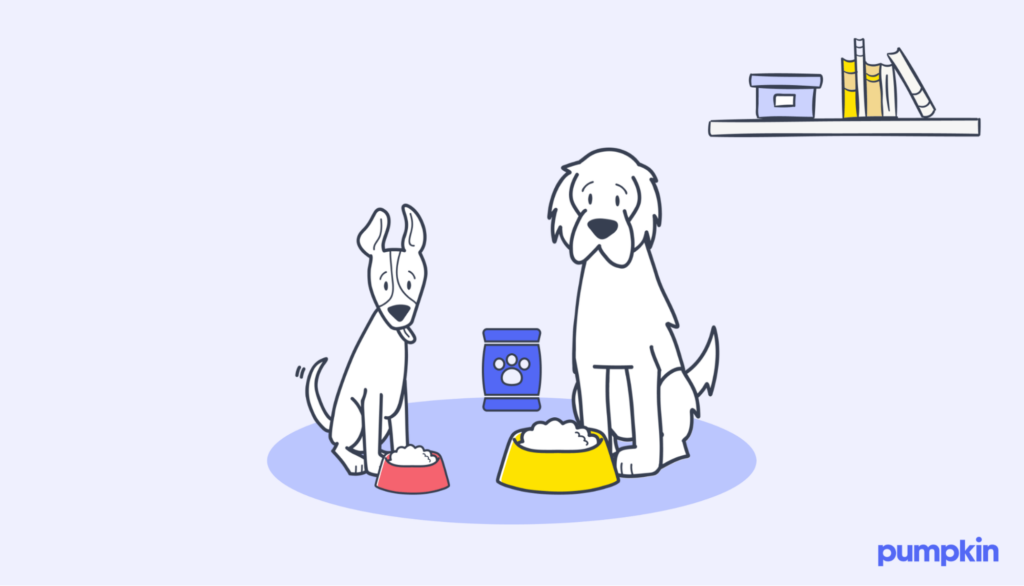Key Points
- Take care to feed your young pup the right portions of puppy food based on their breed, age, and size.
- Puppies thrive on routine, and so small, frequent meals throughout the day help their tiny tummies stay happy and healthy.
- Switching to adult food at the right time keeps your pup on track for a lifetime of tail wags and good health.
Puppies are bundles of joy and energy, bouncing from play sessions to chew toys and romping across your yard, all before crashing into long naps to recharge. They use up energy just as quickly as they gain it, making proper nutrition critical for their growth and well-being.
When you give your puppy the right amount of food, you aren’t just satisfying their seemingly endless appetite. You’re also fueling their development and setting them up for a healthy future.
So, how much should you feed your puppy? In this guide, we’ll provide exact portion sizes and explore the right way to keep your pup well-fed.
Focus on precision and portion control
After they’re weaned, puppies require special food specifically designed for young, growing dogs. Despite their small size, puppies actually need more food than adult dogs.
You need to know exactly how much food to feed your dog to support their development. Don’t be swayed by those big, pleading eyes. Instead, start with the feeding guidelines on the puppy food package, which should include guidelines tailored to their weight and age.
For example, a 10-pound puppy might need 1 cup of food daily, while a 50-pound puppy could require closer to 3 cups. Divide these portions into smaller meals throughout the day to keep their energy stable (and their tummies happy).
With a Pumpkin Dog Insurance plan, 90% cash back on eligible vet bills is an option for everyone. Don’t wait to protect your pup — fetch a free quote today!
Remember: For all puppies, portion control and precision are crucial:
- Use a measuring cup to avoid overfeeding.
- Monitor your puppy’s weight and adjust portions as they grow.
- Avoid leaving food out all day; instead, stick to a feeding schedule.
Finally, keep an eye on their weight as they grow. Your pup should have a trim waist and ribs you can feel but not see.
How many calories does your puppy need?
Your puppy’s daily calorie needs depend on their size, age, and activity level. These needs are calculated using their Resting Energy Requirement (RER). Basically, it’s the minimum number of calories they need to stay healthy. Puppies are like tiny turbo engines: they burn through energy fast, and their diet needs to keep up.
Think of calories as fuel: too little and your pup runs out of energy; too much and they risk unhealthy weight gain. Use our veterinarian-reviewed puppy feeding chart (or consult your vet) as a quick guide on how much to feed a puppy by weight.

Please note that this puppy feeding guide contains general guidelines. If you have a pure-bred dog, they may need more or less based on the size of their breed.
Large-breed puppies, like Great Danes and Bernese Mountain Dogs, need food designed to support growing bones but at a slower pace. (Feed them too much too soon, and it could cause developmental problems.) Toy breeds, like Chihuahuas and Yorkies, thrive on frequent, calorie-dense meals to match their high metabolism. Checking with your vet is always a smart idea, especially when introducing new dog foods
How often should I feed my puppy?
Puppies need frequent fuel to keep up with their mischief — and, of course, their developing bones, joints, brains, hearts, and paws.
Vets typically recommend that puppies 6-12 weeks old eat four meals per day. Puppies 3-6 months drop to three feedings per day. Once they reach 6-12 months, feedings should be twice a day.
For toy or small-breed puppies under 8 weeks of age, meals should be more frequent to prevent hypoglycemia — a dangerous drop in blood sugar. Avoid going more than three waking hours between feedings for these pint-sized puppies.
No matter your puppy’s size, serve their last meal at least 2 hours before bedtime to aid digestion and ensure a comfortable night’s sleep. When in doubt, talk to your veterinarian.
What about treats?
New pet parents love to spoil their new furry bundle of joy, and so you’re hardly the first pet parent to wonder, “How many treats can I give my puppy?” In general, we always recommend sticking to the 10% rule with dog treats. That means 90% of your puppy’s daily calories should come from their dog food, and no more than 10% from treats.
While your puppy is young, share human food very cautiously. Your new best friend can easily get an upset stomach or a case of puppy diarrhea from table scraps. You should also consult our cheat-sheet to human foods you can (and definitely can’t) share with puppies.
What type of puppy food is best?
Choosing the right type of food for your puppy can feel overwhelming, but a few key guidelines can simplify the process. The best puppy formula is one that meets the standards set by the Association of American Feed Control Officials (AAFCO).
Here’s what to look for on the label:
- A named protein (like chicken, beef, or fish) should be the first ingredient. Avoid generic terms like “meat” or “byproducts.”
- Calcium and phosphorus for strong bones and teeth.
- DHA, an omega-3 fatty acid, supports brain development and vision.
- No fillers like corn, soy, or artificial additives
You can choose between wet puppy food or dry food, or even a mix of both. Wet food is hydrating and often more palatable, while dry food helps maintain dental health and is easy to store. Experiment to see what your puppy prefers. Some enjoy classic chicken-based kibble, while others might love more exotic options like salmon or bison.
Remember, quality matters more than price. High-quality dog food is more expensive upfront, but it’s also more nutrient-dense. This means you can feed smaller portions while making sure your pup gets the balanced diet they need.
Finally, if you’re bringing your puppy home from a dog breeder, then use the same pet food as the breeder for the first week or so.
When to transition to adult dog food

Puppyhood flies by, and before you know it, your furry friend will be ready for the next chapter — and adult dog food. You should switch to adult food when your puppy has reached about 80% of their estimated adult size.
Puppies mature at different rates depending on their breed. Smaller breeds, like Dachshunds, typically reach adulthood by 9-12 months. Larger breeds, such as Labs, can take up to 18-24 months to fully mature. Follow your vet’s guidance and keep an eye on their growth milestones.
Switching from puppy to adult food too soon can leave your pup lacking the extra calories and nutrients they need for development. On the flip side, staying on calorie-dense puppy food for too long may lead to obesity, which can affect their joints and overall health.
How to make the transition
Transition gradually over 7–10 days to avoid tummy troubles. Start by mixing a small amount of adult food with their puppy food, gradually increasing the ratio of adult food each day. By the end of the transition, your pup should be fully adjusted.
Curious, growing puppies can find themselves in all sorts of mischief. Feeding them the right dog and puppy food gives them the best start in life, but you can’t plan for everything. Pet insurance can help make sure quality care is available (and affordable) when the unexpected happens. Learn more about how Pumpkin Pet Insurance plans can help cover eligible vet bills for future accidents and illnesses.
FAQs
- https://nutrisourcepetfoods.com/blog/pet-parents/large-and-small-breed-dog-foods/
- https://wilsonvet.net/metabolic-food-requirements-for-your-pet/
- https://vetcalculators.com/calories.html
- https://www.akc.org/expert-advice/health/hypoglycemia-in-dogs/
- https://www.aafco.org/https://www.naturesmenu.co.uk/blog-switching-puppy-to-adult-food.html
- https://www.akc.org/expert-advice/health/puppy-feeding-fundamentals/




